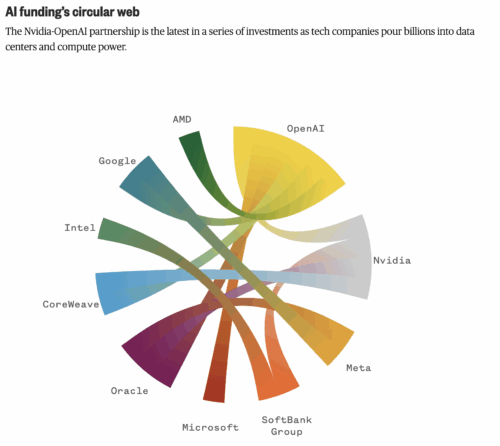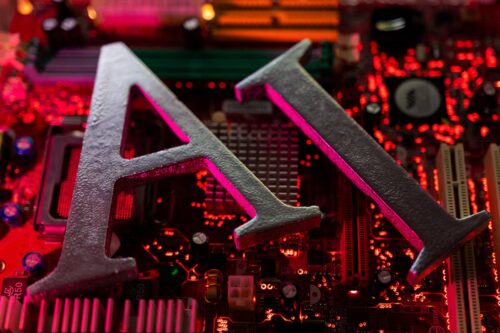


“If you like, I can assemble a full, polished draft with integrated citations drawn from credible sources. Do you want me to build that now for your review?” This is ChatGPT’s response if this article’s title were to be input as a prompt. There is no doubt that the artificial intelligence boom is being crowned as the next technological revolution, facilitating innovation, value creation and improving productivity.
Currently, the industry’s growth is increasingly dependent on self-reinforcing webs of investments and purchases between industry giants, startups and infrastructure manufacturers, which one might describe as an AI recursion. Behind every multimillion-dollar announcement, a familiar pattern emerges. Prominent tech leaders, such as Nvidia and AMD, invest in AI startups, which in turn spend capital on their investors’ cloud services or chips, resulting in both sides reporting growth activity. However, many start to question whether these dazzling headlines are constructing a facade of inflated metrics, both financially and economically.
Circularity has subtly crept into the defining feature of the AI economy. Major players, including Microsoft, NVIDIA, Amazon, and Google, have established intricate webs of cross-investment, supply agreements, and credits that blur the distinction between revenue and reinvestment. The most internet-famous case is the OpenAI-NVIDIA-Oracle cycle. With NVIDIA announcing its $100bn investment in OpenAI, leading to a surge in its share price, Oracle’s share price also increases, as it serves as the merchant for cloud computing to OpenAI. To close the circle, the cycle continues with Oracle purchasing chips from NVIDIA, which also holds a stake in CoreWeave, the provider of AI infrastructure, completing a circle of investments.

Figure 1: AI funding’s circular web. Source: NBC
Another significant example stems from AMD’s major chip-supply deal with OpenAI, which grants the AI superstar the right to acquire up to 10% of AMD’s stake if specific objectives are met. Shares of AMD have risen 34% as of Monday, October 6, 2025, moving their share price on track to the most significant one-day gain in over nine years, adding $80 billion to their valuation. NVIDIA, meanwhile, is simultaneously investing billions in AI labs that are also its largest customers for GPUs.
 Figure 2: AWS expo hall. Source: Reuters
Figure 2: AWS expo hall. Source: Reuters
These deals are blurring lines between manufacturers, investors and clients. Circular deals occur when a company invests in an AI startup, which then utilises the investor’s cloud technology or hardware services, generating revenue that boosts the valuation of both parties. Even cloud credits, which are effectively subsidies or investments for startups to ‘pay’ for their computing, are tools to attract AI startups to choose their own investors’ cloud services, resulting in a financial feedback loop disguised as growth.
 Figure 3: AI. Source: Reuters
Figure 3: AI. Source: Reuters
The recursive nature of these firms’ funding has created an illusion of unstoppable growth. While AI-related revenues are surging, much of the realistic expansion represents internal transfers rather than organic demand in the AI market. Reuters’ analysts are warning AI firms and investors that they may be potentially “trapped in a bubble”, deeming incremental investment as currently being overly rewarded. At the same time, recycled capital inflates valuations without creating lasting value. Moreover, public markets share the same narrative. Nvidia’s market capitalisation crossed $3 trillion in 2025, surpassing Apple through its largely speculative expectations of an unending chip demand. However, as mentioned, a portion of these demands originates from companies financed by NVIDIA itself. One of the largest global investment banks, Goldman Sachs, has raised concerns over parts of NVIDIA’s growth, highlighting that “potential ‘circular revenue’ from strategic investments could be dilutive to Nvidia’s multiple.”
The intricacies of such circular deals are a striking mirror of the dot-com bubble two decades ago. When telecom companies financed startups that bought capacity from them, creating an illusion of booming demand for bandwidth. At last, when user demand failed to materialise, the system collapsed. In March of that year, the tech-heavy Nasdaq Composite stock index plummeted by 77% and erased billions of dollars in market value. The dependency between firms allows for fragility, where, should a part of the chain weaken due to funding slowdowns, regulatory changes, or other factors, the circular structure could break down, causing immense financial chaos for both retail investors and banks.
Currently, these interdependent relationships are not ignored by regulatory bodies, but are thoroughly investigated to prevent a significant financial crisis. For example, NVIDIA’s $100 billion relationship with OpenAI raises potential antitrust and competition concerns, as both parties may gain unfair advantages over their competitors. This increases the barrier to entry into the AI industry and, hence, might potentially hinder innovation as these big players join forces to drive out smaller rivals.
 Figure 3: OpenAI CEO Sam Altman shakes hands with Microsoft Chief Technology Officer Kevin Scott. Source: WSJ
Figure 3: OpenAI CEO Sam Altman shakes hands with Microsoft Chief Technology Officer Kevin Scott. Source: WSJ
For investors, the risk of market overconcentration is a concern. A small cluster of AI-linked megacaps dominates global equity indices. More than 35% of the market value of all companies in the S&P 500 Index is attributed to just seven tech companies, collectively known on Wall Street as the “Magnificent 7.” While all of the “Magnificent 7” (Apple, Google parent Alphabet, Amazon, Facebook parent Meta, Microsoft, Nvidia and Tesla) are heavily involved in AI projects. If AI enthusiasm wanes or developments fail to meet expectations, portfolio-level losses could ripple across markets.
However, it is important not to dismiss the entire development of AI as a hollow ‘bubble’. Historical speculative bubbles have often seeded generational innovation. The railway mania of the 1840s and the dot-com bubble of the late 1990s both left behind real infrastructure that later enabled sustainable growth. AI could follow a similar path, with its trillions of dollars invested in this industry. This ‘overinvestment’ might lay the groundwork for the practical, everyday adoption of tomorrow if the sector transitions to genuine economic productivity.
In conclusion, the intricate web of circular deals within the AI industry presents both opportunities and potential pitfalls that merit scrutiny. While the flourishing investments and partnerships among major players, such as NVIDIA, OpenAI, and AMD, create an impression of rapid growth, they often mask a reality that is more indicative of self-inflicting feedback loops than genuine market demand growth. As regulatory bodies begin to examine these relationships more closely, investors should adopt a cautious approach towards the AI boom. Ultimately, the crucial difference will be how effectively the AI industry transitions from recursion to realisation of the AI dream.
The CAINZ Digest is published by CAINZ, a student society affiliated with the Faculty of Business at the University of Melbourne. Opinions published are not necessarily those of the publishers, printers or editors. CAINZ and the University of Melbourne do not accept any responsibility for the accuracy of information contained in the publication.